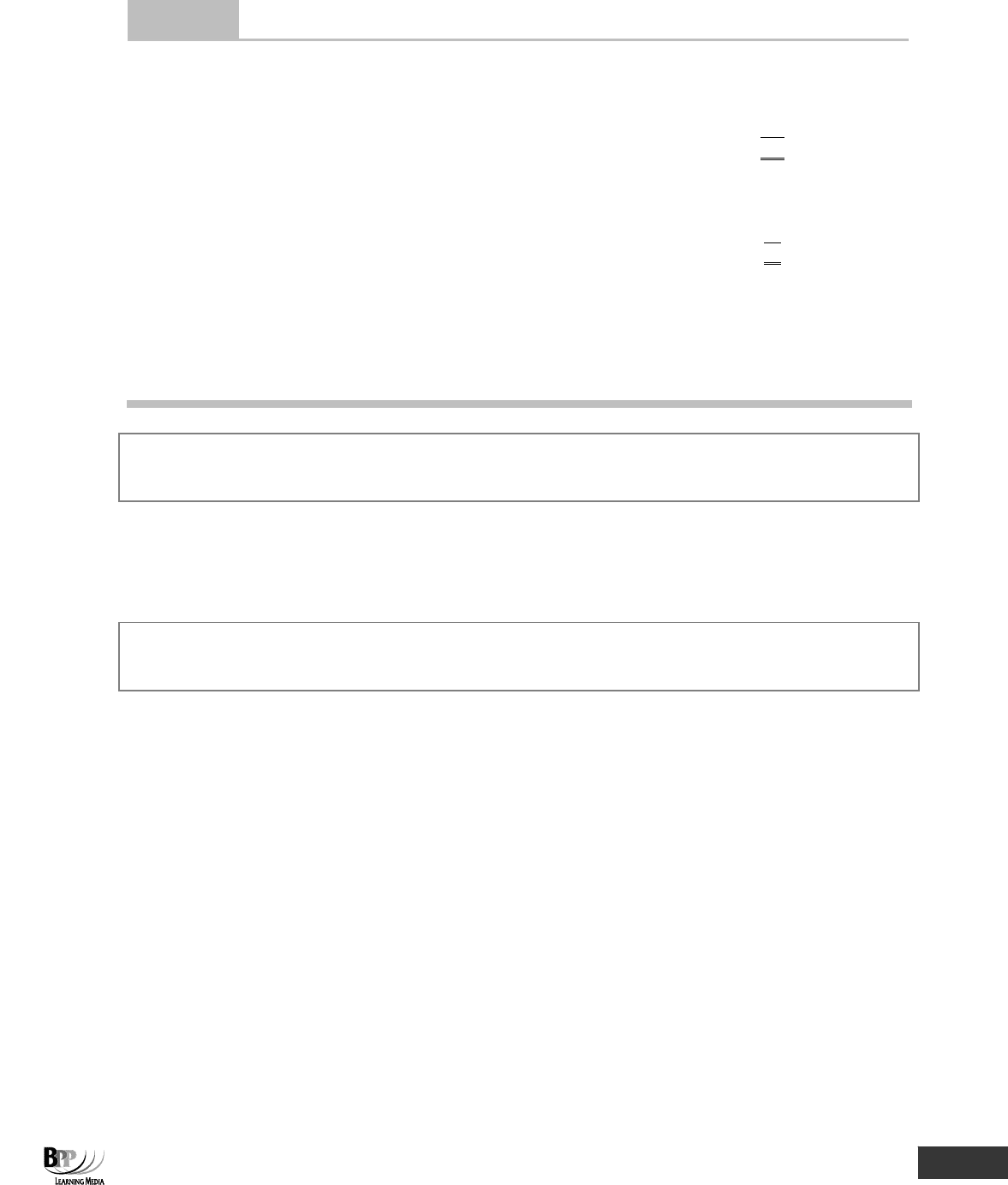CIMA - C1 Fundamentals of Management Accounting
Подождите немного. Документ загружается.


160
7: Standard costing ⏐ Part B Standard costing
(b) By measuring the standard hours of output in each quarter, a more useful output measure is obtained.
Quarter 1
Quarter 2
Standard hours
Standard
Standard
Product
per unit
Production
hours
Production
hours
Plate
1
/
2
1,000
500
800
400
Mug
1
/
3
1,200
400
1,500
500
Eggcup
1
/
4
800
200
900
225
1,100
1,125
The output level in the two quarters was therefore very similar.
5 Standard labour costs and incentive schemes
Bonus/incentive schemes often incorporate labour standards as targets.
5.1 Remuneration methods
(a) Time-based systems. These are based on the principle of paying an employee for the hours attended,
regardless of the amount of work achieved (wages = hours worked × rate of pay per hour).
(i) Overtime premium = extra rate per hour for hours over and above the basic hours.
(ii) Quality of output is more important than quantity of output.
(iii) There is no incentive for improvements in employee performance.
(b) Piecework systems. Here the employee is paid according to the output achieved (wages = units produced
× rate of pay per unit).
(c) Incentive/bonus schemes. There are a variety of these schemes, all of which are designed to encourage
workers to be more productive.
We’re going to be looking at piecework systems and incentive/bonus schemes and how standard labour costs can be
used in them.
5.2 Piecework schemes
5.2.1 Straight piece rate schemes
A type of scheme where the employee is paid a constant rate per unit of output is called a straight piece rate scheme.
Suppose for example, an employee is paid $1 for each unit produced and works a 40 hour week. Production overhead is
added at the rate of $2 per direct labour hour.
Pay Conversion Conversion
Weekly production (40 hours) Overhead cost cost per unit
Units $ $ $ $
40 40 80 120 3.00
50 50 80 130 2.60
60 60 80 140 2.33
70 70 80 150 2.14
As the worker's output increases, their wage increases and at the same time unit costs of output are reduced.
FA
S
T F
O
RWAR
D
181433 www.ebooks2000.blogspot.com

Part B Standard costing ⏐ 7: Standard costing
161
These schemes can be unfair to employees if there are production problems, therefore many piecework schemes offer a
guaranteed minimum wage, so that employees do not suffer loss of earnings when production is low through no fault
of their own.
5.2.2 Schemes with standard time allowances
If an employee makes several different types of product, it may not be possible to add up the units for payment
purposes. Instead, a standard time allowance is given for each unit to arrive at a total of piecework hours for payment.
For example, suppose an employee is paid $8 per piecework hour produced. In a 40 hour week the employee produces
the following output.
Piecework time allowed
per unit
15 units of product X 0.5 hours
20 units of product Y 2.0 hours
Piecework hours produced are as follows.
Product X
15 × 0.5 hours
7.5 hours
Product Y 20 × 2.0 hours
40.0
hours
Total piecework hours
47.5
hours
Therefore employee's pay = 47.5 × $8 = $380 for the week.
5.2.3 Differential piecework schemes
Differential piecework schemes offer an incentive to employees to increase their output by paying higher rates for
increased levels of production. For example:
up to and including 80 units, rate of pay per unit in this band = $1.00
81 to 90 units, rate of pay per unit in this band = $1.20
above 90 units, rate of pay per unit in this band = $1.30
An employee producing 97 units would therefore receive (80 × $1.00) + (10 × $1.20) + (7 × $1.30) = $101.10.
Employers should obviously be careful to make it clear whether they intend to pay the increased rate on all units
produced, or on the extra output only.
5.2.4 Piecework schemes – advantages and disadvantages
• They enjoy fluctuating popularity.
• They are occasionally used by employers as a means of increasing pay levels.
• They are frequently condemned as a means of driving employees to work too hard to earn a satisfactory wage.
• Careful inspection of output is necessary to ensure that quality is maintained as production increases.
182433 www.ebooks2000.blogspot.com

162
7: Standard costing ⏐ Part B Standard costing
Question
Remuneration schemes
Match the descriptions of remuneration schemes to the graphs below.
Tot a l
wages
$
Tot a l
wages
$
Tot a l
wages
$
Activity Activity Activity
Graph
A
Graph
B
Graph C
Descriptions
(a) A basic hourly rate is paid for hours worked, with an overtime premium payable for hours worked in excess of 35
per week.
(b) A straight piecework scheme is operated.
(c) A straight piecework scheme is operated, with a minimum guaranteed weekly wage.
Answer
(a) Graph B
(b) Graph C
(c) Graph A
5.3 Bonus/incentive schemes
In general, bonus schemes were introduced to compensate workers paid under a time-based system for their inability to
increase earnings by working more efficiently. Various types of incentive and bonus schemes have been devised which
encourage greater productivity. The characteristics of such schemes are as follows.
(a) A target is set and actual performance is compared with target. Here is where we see the role of standard
labour costs.
(b) Employees are paid more for their efficiency.
(c) In spite of the extra labour cost, the unit cost of output is reduced and the profit earned per unit of sale is
increased; in other words the profits arising from productivity improvements are shared between
employer and employee.
(d) Morale of employees should be expected to improve since they are seen to receive extra reward for extra
effort.
183433 www.ebooks2000.blogspot.com

Part B Standard costing ⏐ 7: Standard costing
163
5.3.1 Conditions for successful operation of incentive schemes
Whatever scheme is used, it must satisfy certain conditions to operate successfully.
(a) Its objectives should be clearly stated and attainable by the employees.
(b) The rules and conditions of the scheme should be easy to understand and not liable to be misinterpreted.
(c) It must win the full acceptance of everyone concerned including, of course, trade union negotiators and
officials.
(d) It should be seen to be fair to employees and employers. Other groups of employees should not feel
unjustly excluded from the scheme, as their work might be affected by their dissatisfaction.
(e) The bonus should ideally be paid soon after the extra effort has been made by the employees, to
associate the ideas of effort and reward.
(f) Allowances should be made for external factors outside the employees' control which reduce their
productivity such as machine breakdowns or raw materials shortages.
(g) Only those employees who make the extra effort should be rewarded. It would not be an incentive, for
example, to institute a scheme in all factories in a country-wide organisation and to pay a productivity
bonus to employees in London for work done by employees in a factory in the North of England
(especially if these North of England employees fail to get an adequate bonus for their efforts as a result of
this sharing).
(h) The scheme must be properly communicated to employees.
5.3.2 Types of incentive schemes
There are many possible types of incentive scheme. Some organisations employ a variety of incentive schemes. A
scheme for a production labour force may not necessarily be appropriate for clerical workers. An organisation's incentive
schemes may be regularly reviewed, and altered as circumstances dictate.
(a) A high day-rate system is an incentive scheme where employees are paid a high hourly wage rate in the
expectation that they will work more efficiently than similar employees on a lower hourly rate in a different
company.
(b) Under an individual bonus scheme, individual employees qualify for a bonus on top of their basic wage,
with each person's bonus being calculated separately.
(c) Where individual effort cannot be measured, and employees work as a team, an individual incentive
scheme is impractical but a group bonus scheme is feasible.
(d) In a profit sharing scheme, employees receive a certain proportion of their company's year-end profits
(the size of their bonus being related to their position in the company and the length of their employment
to date).
(e) Companies operating incentive schemes involving shares use their shares, or the right to acquire them,
as a form of incentive.
5.3.3 Example: incentive schemes
EF Co manufactures a single product. Its work force consists of 10 employees, who work a 36-hour week exclusive of
lunch and tea breaks. The standard time required to make one unit of the product is two hours, but the current efficiency
(or productivity) ratio being achieved is 80%. No overtime is worked, and the work force is paid $8 per attendance hour.
Because of agreements with the work force about work procedures, there is some unavoidable idle time due to
bottlenecks in production, and about four hours per week per person are lost in this way.
184433 www.ebooks2000.blogspot.com

164
7: Standard costing ⏐ Part B Standard costing
The company can sell all the output it manufactures, and makes a 'cash profit' of $40 per unit sold, after deducting
currently achievable costs of production but before deducting labour costs.
An incentive scheme is proposed whereby the work force would be paid $10 per hour in exchange for agreeing to new
work procedures that would reduce idle time per employee per week to two hours and also raise the efficiency ratio to
90%. Evaluate the incentive scheme from the point of view of profitability.
Solution
The current situation
Hours in attendance 10 × 36 = 360 hours
Hours spent working 10 × 32 = 320 hours
Units produced, at 80% efficiency
100
80
2
320
×
= 128 units
$
Cash profits before deducting labour costs (128 × $40)
5,120
Less labour costs ($8 × 360 hours)
2,880
Net profit
2,240
The incentive scheme
Hours spent working 10 × 34 = 340 hours
Units produced, at 90% efficiency
100
90
2
340
× = 153 units
$
Cash profits before deducting labour costs (153 × $40)
6,120
Less labour costs ($10 × 360)
3,600
Net profit
2,520
In spite of a 25% increase in labour costs, profits would rise by $280 per week. The company and the workforce would
both benefit provided, of course, that management can hold the work force to their promise of work reorganisation and
improved productivity.
If an assessment question requires you to calculate labour costs with a bonus system, you must read the description of
the system carefully and use the data supplied to calculate the required cost.
Question
Labour schemes
The following data relate to work at a certain factory.
Normal working day 8 hours
Basic rate of pay per hour $6
Standard time allowed to produce 1 unit 2 minutes
Premium bonus 75% of time saved at basic rate
What will be the labour cost in a day when 340 units are made?
A $48 B $51 C $63 D $68
Assessment
focus point
185433 www.ebooks2000.blogspot.com

Part B Standard costing ⏐ 7: Standard costing
165
Answer
The correct answer is C.
Minutes
Standard time for 340 units (× 2 minutes)
680
Actual time (8 hours per day)
480
Time saved
200
$
Bonus = 75% × 200 minutes × $6 per hour
15
Basic pay = 8 hours × $6
48
Total labour cost
63
Using basic MCQ technique you can eliminate option A because this is simply the basic pay without consideration of any
bonus. You can also eliminate option D, which is based on the standard time allowance without considering the basic
pay for the eight-hour day. Hopefully you were not forced to guess, but had you been you would have had a 50% chance
of selecting the correct answer (B or C) instead of a 25% chance because you were able to eliminate two of the options
straightaway.
Questions on bonus and incentive schemes may be non-numerical as well as numerical. Make sure you understand the
advantages and disadvantages of the various schemes.
5.4 Accounting for labour costs
The bookkeeping entries for wages will be covered in Chapter 11 but it is worth mentioning here that there is a
distinction made between direct labour and indirect labour.
Make sure that you read any assessment questions on wages very carefully. You may be required to calculate direct
labour costs, indirect labour costs or both.
The basic distinction for classification of labour costs is that the labour costs of production workers are direct costs and
the labour costs of other workers are indirect costs. However there are two specific areas where the costs of the
production workers are often treated as indirect rather than direct.
When overtime is worked by employees they tend to be paid an additional premium over the general hourly rate, known
as the overtime premium. The overtime premium is generally treated as an indirect cost rather than a direct cost of
production. However there is an exception to this – if a customer requests that overtime is worked in order to complete a
job earlier then the entire overtime payment will normally be treated as a direct cost of the job.
When overtime is worked by employees they tend to be paid an additional premium over the general hourly rate, known
as the overtime premium. The overtime premium is generally treated as an indirect cost rather than a direct cost of
production. However there is an exception to this – if a customer requests that overtime is worked in order to complete a
job earlier then the entire overtime payment will normally be treated as a direct cost of the job.
At some point during the working day it is entirely possible that production workers find that there is no work for them to
do. This could be due to factors such as production scheduling problems or machine breakdowns. These hours which
are paid for but during which no work is being done are known as idle time. The cost of idle time hours tends to be
treated as an indirect labour cost.
Assessment
focus point
Assessment
focus point
186433 www.ebooks2000.blogspot.com

166
7: Standard costing ⏐ Part B Standard costing
Question
Direct and indirect labour cost
During the week ending 30 June 20X3 the direct production workers in a factory worked for 840 hours in total. Of these
hours 60 were idle time hours and 100 were overtime hours. The hourly rate of pay is $8.00 with overtime hours being
paid at time and a half.
During the same week the indirect workers worked for 120 hours at a rate of $6.00 per hour with no overtime hours.
What is the direct labour cost and the indirect labour cost for the week?
Direct labour cost Indirect labour cost
A $5,440 $2,400
B $6,240 $1,600
C $6,640 $1,200
D $6,720 $1,120
Answer
Answer B
$
Direct labour (840 – 60) × $8.00
6,240
Indirect labour
$
Indirect workers 120 × $6.00
720
Direct workers overtime premium
100 hours × $4
Direct workers idle time
60 hours × $8
480
1,600
Chapter Roundup
• Standard costing is the preparation of standard costs to value inventories/cost products and/or to use in variance
analysis, a key management control tool.
• Standards for each cost element are made up of a monetary component and a resources requirement component.
• Performance standards are used to set efficiency targets. There are four types: ideal, attainable, current and basic.
• There are a number of advantages and disadvantages of standard costing.
• Standard costing systems can be adapted to remain useful in the modern business environment.
• The standard hour can be used to overcome the problem of how to measure output when a number of dissimilar
products are manufactured.
• Bonus/incentive schemes often incorporate labour standards as targets.
187433 www.ebooks2000.blogspot.com

Part B Standard costing ⏐ 7: Standard costing
167
Quick Quiz
1 Choose the correct words from those highlighted.
A standard cost is a planned/historical unit/total cost.
2 The only use of standard costing is to value inventory.
True
False
3 A control technique which compares standard costs and revenues with actual results to obtain variances which are used
to stimulate improved performance is known as:
A Standard costing C Budgetary control
B Variance analysis D Budgeting
4 Standard costs may only be used in absorption costing.
True
False
5 Four types of performance standard are
(a) ………………………….. (c) …………………………..
(b) ………………………….. (d) …………………………..
6 The formula for standard material cost per unit = ………………………….
7 List three problems in setting standards.
(a) …………………………………………….
(b) …………………………………………….
(c) …………………………………………….
8 The standard time per unit of product W is five hours. Ten employees work a 40-hour week. Idle time is two hours per
employee per week. Efficiency levels are 125%.
The weekly output is
units.
9 Which of the following are advantages of standard costing?
A Standards are an aid to more accurate budgeting
B Cost consciousness is stimulated
C Inflation can be dealt with easily
D The principle of management by exception can be operated
10 L Co has paid its staff for the following number of hours in September.
Basic pay 14,000 hours
Overtime 3,000 hours
Idle time 1,000 hours
Basic pay is paid at $20 per hour and overtime is paid at basic pay plus 20%
Calculate the indirect labour cost for September. $
188433 www.ebooks2000.blogspot.com

168
7: Standard costing ⏐ Part B Standard costing
Answers to Quick Quiz
1 A standard cost is a planned unit cost.
2 False. It has a number of uses including:
(a) To value inventory and cost production for cost accounting purposes.
(b) To act as a control device by establishing standards and highlighting activities that are not conforming to plan
and bringing these to the attention of management.
3 A
4 False
5 (a) Ideal (c) Current
(b) Attainable (d) Basic
6 Standard material cost per unit = standard material usage × standard material price
7 (a) Deciding how to incorporate inflation into planned unit costs
(b) Agreeing on a performance standard (attainable or ideal)
(c) Deciding on the quality of materials to be used (a better quality of material will cost more, but perhaps reduce
material wastage)
(d) Estimating materials prices where seasonal price variations or bulk purchase discounts may be significant
(e) Finding sufficient time to construct accurate standards as standard setting can be a time-consuming process
(f) Incurring the cost of setting up and maintaining a system for establishing standards
(g) Dealing with possible behavioural problems, managers responsible for the achievement of standards possibly
resisting the use of a standard costing control system for fear of being blamed for any adverse variances
8 Active hours = (40 – 2) × 10 = 380
Units produced = 380/5 × 125% =
95
units
9 A, B and D
If standards are planned carefully they can be an aid to more accurate budgeting. Cost consciousness can be stimulated
when a target of efficiency is set for employees. Variances enable the principle of management by exception to be
operated by setting tolerance limits.
10
£3
2
,000
Idle time is treated as an indirect cost. The overtime premium (which means the 20% part only) is also treated as an
indirect cost.
Overtime premium = $20 x 20%
= $4 per hour
Overtime: 3,000 x $4 = $12,000
Idle time: 1,000 x $20 =
$20,000
Indirect labour cost =
$32,000
Now try the questions below from the Question Bank
Question numbers Page
32-36 358
189433 www.ebooks2000.blogspot.com

169
Topic list Learning outcomes Syllabus references Ability required
1 Variances C(iv) C(3) Application
2 Direct material variances C(iv) C(3) Application
3 Direct labour variances C(iv) C(3) Application
4 Variable overhead variances C(iv) C(3) Application
5 The reasons for cost variances C(vi) C(3) Analysis
6 Sales variances C(iv) C(3) Application
7 Operating statements C(v) C(4) Application
8 Deriving actual data from standard cost
details and variances
C(iv) C(3) Application
9 Inter-relationships between variances C(vi) C(3) Analysis
Variance analysis
Introduction
The actual results achieved by an organisation during a reporting period (week, month, quarter, year)
will, more than likely, be different from the expected results (the expected results being the standard
costs and revenues which we looked at in the previous chapter). Such differences may occur between
individual items, such as the cost of labour and the volume of sales, and between the total expected
contribution and the total actual contribution.
Management will have spent considerable time and trouble setting standards. Actual results have
differed from the standards. The wise manager will consider the differences that have occurred
and use the results of these considerations to assist in attempts to attain the standards. The wise
manager will use variance analysis as a method of control.
This chapter examines variance analysis and sets out the method of calculating the following
variances.
• Direct material variances
• Direct labour variances
• Variable overhead variances
• Sales variances
We will then go on to look at the reasons for variances.
We will then build on the basics by introducing, among other things, operating statements.
Finally we will examine two further topics. We will consider how actual data can be derived from
standard cost details and variances and we'll look at the interrelationship between various
variances.
190433 www.ebooks2000.blogspot.com
